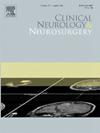Blend sign as a prognostic factor for spontaneous intracerebral hemorrhage: A systematic review and meta-analysis
IF 1.8
4区 医学
Q3 CLINICAL NEUROLOGY
引用次数: 0
Abstract
Background and objectives
The blend sign (BS) is a known predictor of hemorrhage expansion. However, its prognostic value remains unclear. Therefore, we aimed to compare functional and mortality outcomes between intracerebral hemorrhage (ICH) patients with and without BS.
Methods
We searched PubMed, EMBASE, Web of Science, and Cochrane Library for studies comparing patients with and without BS who underwent either conservative treatment or surgical evacuation for spontaneous ICH. Outcomes were functional status, hemorrhage expansion, mortality, and initial hematoma volume. Statistical analysis was performed using R software (version 4.4.0), and heterogeneity was assessed with I2 statistics.
Results
We included 13 studies with a total of 8685 patients, of whom 5131 (59.08 %) were male. The mean age was 64.64 ± 4.92 years, and the follow-up period ranged from 30 to 360 days. Poor neurological outcomes (OR 1.71, 95 % CI: 1.23─2.37, p < 0.01, I2 = 84.2 %) and hemorrhage expansion (OR 2.11, 95 % CI: 1.36─3.26, p < 0.01, I2 = 42 %) were significantly higher in patients with BS. However, the overall mortality rate (OR 1.56, 95 % CI: 0.95─2.58, p = 0.08, I2 = 0 %) was not statistically different between groups. Furthermore, no significant differences were found in initial hematoma volume (MD 1.26 mL, 95 % CI: −9.94–12.46, p = 0.83, I2 = 92 %).
Conclusion
Patients with blend sign are associated with higher rates of poor neurological outcomes and hemorrhage expansion. Therefore, BS is a clear and easily identifiable finding that, based on our results, can improve patient management and treatment selection.
求助全文
约1分钟内获得全文
求助全文
来源期刊

Clinical Neurology and Neurosurgery
医学-临床神经学
CiteScore
3.70
自引率
5.30%
发文量
358
审稿时长
46 days
期刊介绍:
Clinical Neurology and Neurosurgery is devoted to publishing papers and reports on the clinical aspects of neurology and neurosurgery. It is an international forum for papers of high scientific standard that are of interest to Neurologists and Neurosurgeons world-wide.
 求助内容:
求助内容: 应助结果提醒方式:
应助结果提醒方式:


